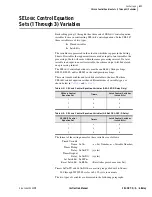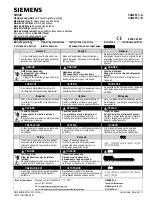
4.24
SEL-387-0, -5, -6 Relay
Instruction Manual
Date Code 20050919
Control Logic
Trip and Close Logic
The third means of unlatching is a Close Failure Detection. This function can
be set OFF if necessary. This function is useful in the event the breaker does
not close in response to energization of the closing circuit. This might be the
result of electrical problems or mechanical binding or breakage. With the
breaker not moving, CLS1 will remain asserted and
OUT105
will stay closed for
an extended period, possibly resulting in an electrical fire, system damage, or
injury to personnel. Within the logic when CLS1 asserts, an input is also sent
to the AND gate at the bottom. The second AND input is 1 if the Close Failure
detection timer (CFD) is set to some value, and 0 if CFD is set to OFF. In our
example, we have selected CFD = 60 cycles (one second). With CFD set to
some value, a timer is started. At the expiration of CFD, an output is asserted
as Relay Word bit CF1T. This bit is pulsed for one processing interval. It is
sent to the OR gate for the unlatch functions and interrupts the closing
process. This prevents the closing circuit from being energized too long. It
also creates the possibility that the OUT105 contact may be damaged by
interrupting the closing circuit current flow. However, the emergency nature
of the situation generally would be worth the risk. The CFT1 bit might also be
used to set a SEL
OGIC
control equation Latch Bit to close a contact, informing
a SCADA system of the aborted closure attempt.
Summary of Contents for SEL-387-0
Page 10: ...This page intentionally left blank ...
Page 16: ...This page intentionally left blank ...
Page 56: ...This page intentionally left blank ...
Page 350: ...This page intentionally left blank ...
Page 388: ...This page intentionally left blank ...
Page 456: ...This page intentionally left blank ...
Page 494: ...This page intentionally left blank ...
Page 528: ...This page intentionally left blank ...











































